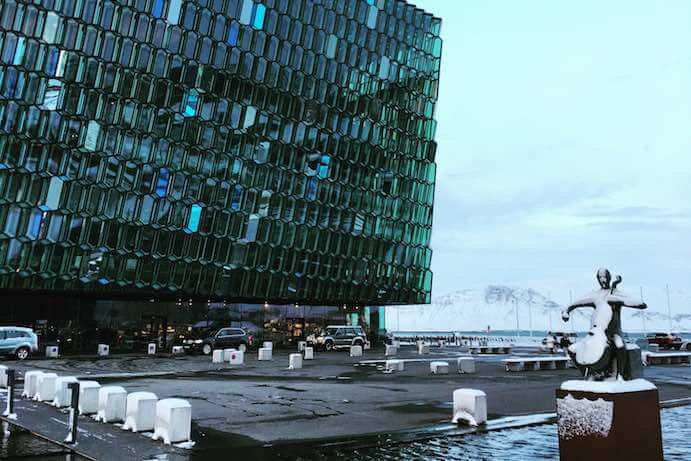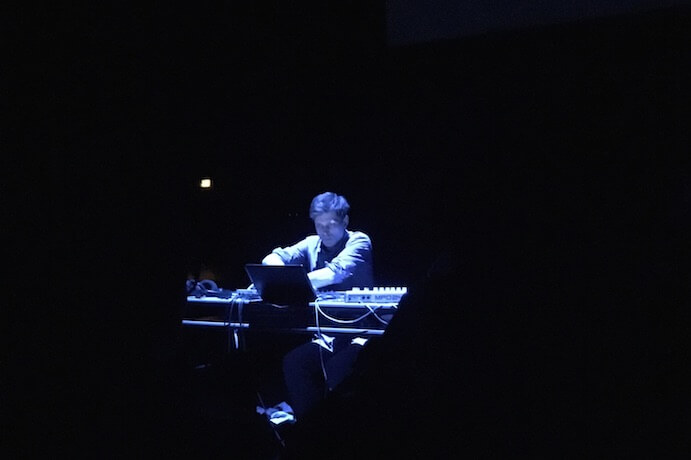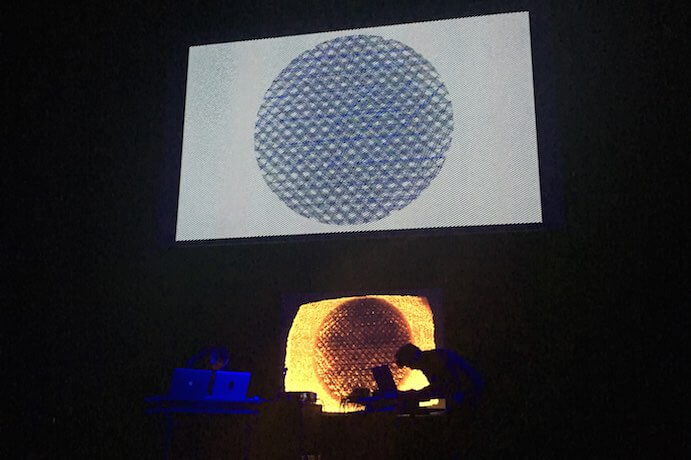The wind screams and howls in Reykjavík. It is strong enough to disturb your gait and to push you around as your feet glide on the layers of ice which cover the ground. Harpa, the concert hall designed by Ólafur Elíasson and built by Henning Larsen Architects, stands in willful isolation to these phenomenal forces of the North. Its crystalline body dazzles onlookers via an LED light array embedded throughout its entire land-facing façade in a luminous imitation of that most mysterious of light-displays, the Aurora Borealis. Like this splintering of ions in the upper atmosphere, the second round of concerts at Dark Music Days dispersed its energy into divergent pathways and fields, unpredictably varied and interesting in a day of music for solo piano, various chamber music configurations, and a program devoted to electronic music and multimedia works.
In the only solo piano concert of the festival, Edda Erlendsdóttir presented a program of unique chronologies. A pianist of remarkable clarity and assurance, she has given performances throughout Europe, the USA, Russia, and China, but is especially active and prolific in her native Iceland. She opened with the world premiere Majka by French-Icelandic composer Tómas Manoury; a duet for electronics and piano in which sounds from the piano underwent realtime granular manipulation and were sent through probabilistic delay chains. Notes were played, then heard backwards, forwards, and truncated while new chords would sweep over the electroacoustic texture. Manoury, who stood in front of a laptop, acted as a conductor at times, measuring and controlling systems of feedback and delay.

Harpa– Photo by Gavin Gamboa
After this engaging collaboration, Erlendsdóttir dove into a youthful work of Olivier Messiaen, “Plainte calme” from his Eight Preludes (1929). It was the only piece she performed from memory, perhaps in acknowledgment of the importance that Messiaen himself placed on this set of Preludes. A sublime stasis was instilled as sounds were shaded with exquisite grace. And then, as if catering to a different part of the same sensorium, Erlendsdóttir played three of Claude Debussy’s Études (1915), difficult pieces which are also his last for the instrument. She handled hand-crossings with ease, and they flowed right at the edge of mezzoforte, bringing to the forefront the essence of its jovial spirit. Her command in the delicate sweeps up and down the piano, with such sensitive timing and rapturous tone, was hypnotic.
Following this was the world premiere of Úlfur Hansson‘s Innstirni. Through a very diatonic and medium motion, the piece unfolded with folk-like melodic passages centered around the intervals of 5ths and 4ths, swaying in and out of repetitive chordal passages. Hafliði Hallgrímsson‘s Five pieces for piano (1971) was a curiosity; a set of atonal miniatures characterized by their need for the utmost precision and balance. Their spritely and conjunctive questioning exemplified why Hallgrímsson is one of Iceland’s leading composers. A staggering sense of darkness and foreboding permeated these short works; heavy lamentations which led us to a final reckoning. Erlendsdóttir ended with the Icelandic premiere of Henri Dutilleux’s 3 Preludes (1988), pieces built upon clusters which brim to the surface under violent pressure. By way of abrupt pauses and relational tension across dissonances, Erlendsdóttir, with what seemed like limitless energy, carved up landscapes replete with danger and acid that culminated in the virtuosic and wild barrenness of the third Prelude.

Edda Erlendsdóttir–Photo by Gavin Gamboa
Since 1987, the chamber ensemble CAPUT has been vigorously workshopping new compositions with a focus centered on young Icelandic composers. Their intriguing program contained two works in particular which stood out for their originality of instrumentation and formal approach: Gunnar Karel Másson‘s Tuba concerto While we walk we sleep, and Guðmundur Steinn Gunnarsson‘s New Work for ensemble. Másson, whose focus is chamber music, intertwines the tendencies towards musical quotation in jazz with aspects of avant-garde entrainment. Embedded throughout While we walk we sleep are hidden motives and quotes from the classical and contemporary literature, purposefully obscure and subliminal; as was described to me by Másson in the subsequent days after this performance, the genesis of his composition preceded on largely intuitive formulations, with the aim to approach it from a hip-hop perspective of sampling and appropriation. Tuba soloist Nimrod Ron gave an incredible performance, executing fantastic feats of tonal diversity and acrobatic arpeggiation. What was remarkable was the sense of space that Másson was able to conjure; a sense of peace and tranquility which at times was overpowering. In Gunnarsson’s piece (which featured full string-section, harpsichords, marimba, bassoon and clarinet) the score was read from four different monitors corresponding to divisions in the ensemble. Longa and Maxima noteheads moved across the screen using a custom proportional notation (à la Berio) that Gunnarsson developed using the Processing language. He is interested in capturing a natural copresence of rhythm gestures that he says cannot be properly emphasized using standard notation. A fascinating piece with a strained, declamatory vibe.

Steindór Gréta Kristinsson– Photo by Gavin Gamboa
The evening ended with an impressive all-electronic concert featuring live performance and playback of distinctive compositions. Lydía Grétarsdóttir’s beautiful five-channel piece Þytur (Wind) used the sounds of birds wings to craft a full-fledged and eloquent structure of accumulation. Jesper Pedersen’s brooding and compelling MMDC featured B&W video paired with sounds from his replica of the ARP 2600 analog modular synthesizer (used by Ben Burtt to create the voice of R2D2 in the original Star Wars). Ríkhardur H. Fridriksson‘s … e mezzo was a meticulously crafted diabolical journey of insectoid noise and unfolding frequencies. Kristín Lárusdóttir’s heartfelt Sofðu nú featured her on stage singing over a vibrant blend of cello and electronics. Steindór Grétar Kristinsson’s live set was a thunderous, glacial mass of drone, expertly controlled. The closing duo, Mankan (Tómas Manoury & Gudmundur Vignir Karlsson), demonstrated an agile audio/visual terrain in a highly interactive setup that was an engaging exploration of open systems of collaboration.
The myriad creative endeavors embodied in these musicians of all different backgrounds and interests spoke volumes of the artistic integrity which exists in plenitude here in Iceland. Despite the geographical isolation, it seems that 21st century solitude is bigger, and has a much clearer picture quality.






















